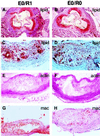T and B lymphocytes play a minor role in atherosclerotic plaque formation in the apolipoprotein E-deficient mouse
- PMID: 9114044
- PMCID: PMC20777
- DOI: 10.1073/pnas.94.9.4642
T and B lymphocytes play a minor role in atherosclerotic plaque formation in the apolipoprotein E-deficient mouse
Abstract
Cellular and humoral immunity have been implicated in the pathogenesis of atherosclerosis. To determine whether an intact immune system is necessary for the formation of atherosclerotic lesions, we have generated immunodeficient mice with hypercholesterolemia and atherosclerosis by crossbreeding the apolipoprotein E (apoE)-deficient mouse with the recombinase activating gene 1 (Rag-1) knockout mouse. Chow-fed immunodeficient mice with targeted disruption in both apoE and Rag-1 (E0/R0) had a 2-fold decrement in aortic root lesion size at 16 weeks of age, compared with immunocompetent littermates, which were heterozygotes at the Rag-1 locus (E0/R1). Nearly all atherosclerotic lesions from chow-fed animals were limited to raised foam cell fatty streaks. In contrast, when a second group of animals was fed a high-fat Western-type diet to accelerate lesion development, there were no differences in either aortic root lesion size or the percent of the total aorta occupied by lesions. Fibrous plaques with well-defined caps and necrotic cores were detected in both Western diet-fed E0/R0 and E0/R1 animals. We conclude that T and B lymphocytes play only a minor role in the rate of forming foam cell lesions, and they are not necessary for the formation of fibroproliferative plaques.
Figures


References
-
- Stemme S, Holm J, Hansson G K. Arterioscler Thromb. 1992;12:206–211. - PubMed
-
- Hansson G K, Jonasson L, Lojsthed B, Stemme S, Kocher O, Gabbiani G. Atherosclerosis. 1988;72:135–141. - PubMed
-
- Jonasson L, Holm J, Skalli O, Bondjers G, Hansson G K. Arteriosclerosis. 1986;6:131–138. - PubMed
-
- Hansson G, Libby P. In: Atherosclerosis and Coronary Artery Disease. Fuster V, Ross R, Topol E, editors. Philadelphia: Lippincott–Raven; 1996. pp. 557–568.
-
- Salonen J T, Yla-Herttuala S, Yamamoto R, Butler S, Korpela H, Salonen R, Nyyssonen K, Palinski W, Witztum J L. Lancet. 1992;339:883–887. - PubMed
Publication types
MeSH terms
Substances
Grants and funding
LinkOut - more resources
Full Text Sources
Other Literature Sources
Medical
Miscellaneous

